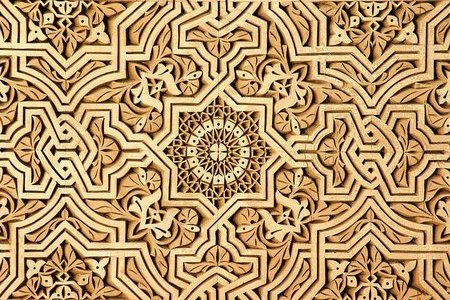Historic Patterns: The Arabesque Style
Mar 06, 2023
One of the most decorative pattern styles there is - and perhaps also the most difficult to create - may be the Arabesque pattern style. In this article you’ll get to know this style a bit, its history and what characterizes it.

Arabesque refers to an elaborate and ornamental pattern style that we associate with Islamic art, design and architecture. It’s based on rhythmic linear patterns of either plain lines and geometric shapes, or of scrolling and interlacing foliage and tendrils - often in combination with other motif elements, like flowers and leaves.

The Arabesque Name
The name Arabesque is a French term, which in turn comes from the Italian word arabesco which means ”in the Arabic style”. This style has had many names throughout history and depending on where in the world you are. Other words are rabeschi, moresque, foliage ornament and Islimi. But let’s stick with Arabesque here, the term that has been most commonly used since the 19th century.
The Arabesque Characteristics
The Arabesque design style has many sub-styles, some more simplified like Moroccan tile, others extremely detailed and elaborate, but let’s take a look at the main principles that characterizes all versions:
Structure
The Arabesque pattern style has a complex structure, which usually consists of a single design, or tile, (not necessarily square) which is reflected and rotated and seamlessly repeated to cover a surface.

There are two main structural elements:
1. The first one consists of lines and angles, reflected and rotated that in turn creates geometric shapes in the negative spaces in between.
2. The second one is the eternal spiral; spiraling lines, seemingly endless, curved and overlapping stems. The designs can be composed with only one of these structural shapes, or both in combination, creating extremely intricate and elaborate designs.
Layout and composition
Another characteristic of Arabesque designs is how the elements are evenly and symmetrical distributed. And symmetry, rhythm and balance between the shapes and lines are very important. It’s considered to represent the completeness and perfection of God. It also makes the patterns appear flat, with no particular or dominating foreground motifs. All motifs are equally important.
Motifs
In the early ages of the Arabesque style, common motifs were stylized Acanthus leaves, palmettes and vines. Some versions of Arabesque patterns are completely abstract, with lines and geometric shapes that only reminds of real objects from nature. In later versions the motifs were still stylized bud more realistically depicted, so that the flowers and plants could be identified. In general, the Arabesque motif elements are geometric shapes, lines in combination with overlapping and scrolled plants, leaves and flowers. Some versions also depict animals.
Use and application
Arabesque patterns are used for all kinds of purposes, but the most common are for book and calligraphy illuminations. Other places where Arabesque designs are applied are on wall friezes, and for embellishing everyday objects such as utensils, fabric and carpets.
Fun pattern design fact
It’s all connected. Arabesque has many different influences and has in turn influenced other design styles throughout history. For example, you can definitely see the eternal spiral used in many background layers of the Arts and Crafts pattern designs. And the reflected motifs and diagonal layout of Damasks are also related to Arabesque structure and motifs.
